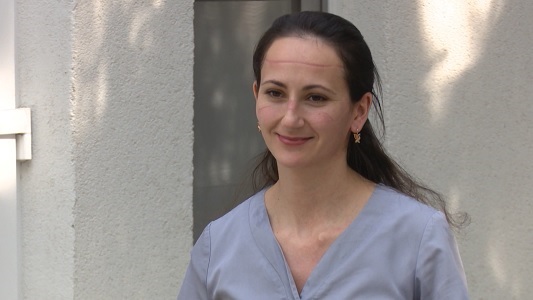The faces of doctors treating patients infected with COVID-19 are marked by goggles, longing for loved ones and hope for victory. One of those doctors is Ana Coeva, a paediatrician at the Emilian Coțaga Children’s Hospital in the Republic of Moldova.
What preoccupies Ana the most is being away from her family – particularly her five-year-old daughter, whom she has chosen not to see for the last month out of fear of infecting her, while she continues to work at the hospital.
“I am grateful that my daughter can stay with her grandparents so I do not risk infecting her with the coronavirus. Her grandmother is very patient, explaining the situation and answering questions – of which there are many: ‘Where is my mother? What is my mother doing? Why isn’t she visiting?’ – but I try to stay in touch online as much as possible. I miss my family dearly.
“I want the people to truly understand the gravity of the situation and to act responsibly. Health care workers risk their own health by going to work. By respecting national health measures, the general population can help significantly,” she explains.
In her early thirties, Ana has four years of experience in the public health system. In the last month she has been wearing protective overalls while providing daily assistance to children suspected of having or confirmed to have COVID-19.
“My work has changed significantly, one important new factor being the low predictability of the disease evolution, the other being the personal protective equipment and the physical distancing measures we need to take.
“Although effective, the protective equipment we wear when treating patients is uncomfortable. It is painful from the moment you put it on, and by the time you take it off, you have marks on the skin left by the goggles. Because we also care for newborns, one-to-two months old, the room must be kept warm, which makes wearing protective overalls even more burdensome. It feels like being in a sauna.
“I am willing to take the risk of treating COVID-19 patients because I cannot turn my back on children who are sick. Like my colleagues, I am determined to provide care to all who need it.
“When we first choose to study medicine, we may not always know what awaits us. I don’t come from a family of doctors who could have helped me prepare for the realities of practicing, but along the way I have come to realize that I could not have chosen any other path for myself.”
WHO collaborated closely with national experts to train paediatricians like Ana in the management of COVID-19 cases among children. Health care professionals were trained in oxygen therapy, chronic lung disease and asthma, management of long-term cough and fever, rehydration methods, psychomotor health and stress management in children and parents, supportive care, and monitoring of condition and deterioration signs in the context of COVID-19. Training modules included simulation exercises on mannequins for remote practice of essential crisis management interventions.









